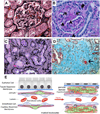MicroRNAs are potential therapeutic targets in fibrosing kidney disease: lessons from animal models
- PMID: 25018773
- PMCID: PMC4090701
- DOI: 10.1016/j.ddmod.2012.08.004
MicroRNAs are potential therapeutic targets in fibrosing kidney disease: lessons from animal models
Abstract
Chronic disease of the kidneys has reached epidemic proportions in industrialized nations. New therapies are urgently sought. Using a combination of animal models of kidney disease and human biopsy samples, a pattern of dysregulated microRNA expression has emerged which is common to chronic diseases. A number of these dysregulated microRNA have recently been shown to have functional consequences for the disease process and therefore may be potential therapeutic targets. We highlight microRNA-21, the most comprehensively studied microRNA in the kidney so far. MicroRNA-21 is expressed widely in healthy kidney but studies from knockout mice indicate it is largely inert. Although microRNA-21 is upregulated in many cell compartments including leukocytes, epithelial cells and myofibroblasts, the inert microRNA-21 also appears to become activated, by unclear mechanisms. Mice lacking microRNA-21 are protected from kidney injury and fibrosis in several distinct models of kidney disease, and systemically administered oligonucleotides that specifically bind to the active site in microRNA-21, inhibiting its function, recapitulate the genetic deletion of microRNA-21, suggesting inhibitory oligonucleotides may have therapeutic potential. Recent studies of microRNA-21 targets in kidney indicate that it normally functions to silence metabolic pathways including fatty acid metabolism and pathways that prevent Reactive Oxygen Species generation in peroxisomes and mitochondria in epithelial cells and myofibroblasts. Targeting specific pathogenic microRNAs in a specific manner is feasible in vivo and may be a new therapeutic target in disease of the kidney.
Keywords: PPARα; ROS; chronic allograft dysfunction; chronic kidney disease; fibrosis; microRNA.
Conflict of interest statement
JSD serves on the Scientific Advistoy Board of Regulus therpeutics and has a Research Grant sponsored by Regulus Therapeutics.
Figures



References
-
- Johnson RJ, et al. Subtle acquired renal injury as a mechanism of saltsensitive hypertension. N Engl J Med. 2002;346(12):913–923. - PubMed
-
- Friedman SL, et al. Therapy for Fibrotic Diseases: Nearing the Start Line. Science Trans. Med. 2012 in press. - PubMed
-
- Ishii Y, et al. Injury and progressive loss of peritubular capillaries in the development of chronic allograft nephropathy. Kidney Int. 2005;67(1):321–332. - PubMed
-
- Schrimpf C, Duffield JS. Mechanisms of fibrosis: the role of the pericyte. Curr Opin Nephrol Hypertens. 2011;20(3):297–305. - PubMed
Grants and funding
LinkOut - more resources
Full Text Sources
Other Literature Sources
